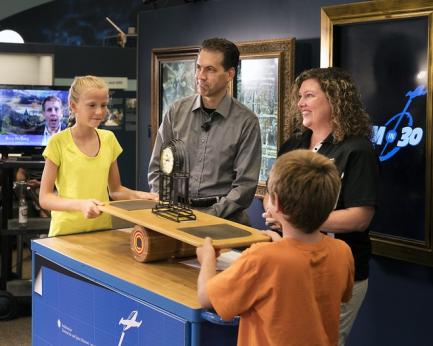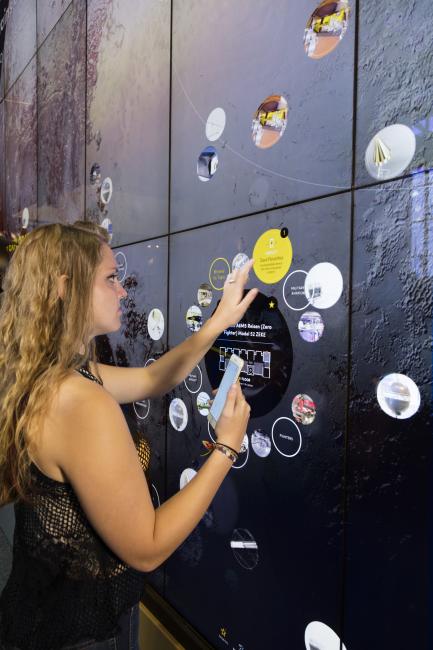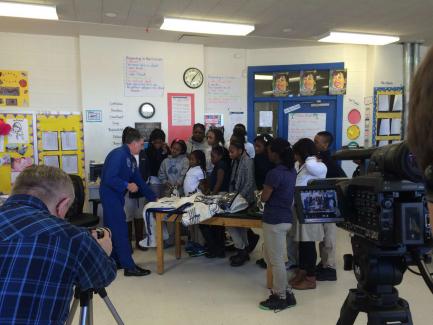The Smithsonian’s National Air and Space Museum offers new ways of learning as students prepare for the school year. Using the world’s largest aerospace collection, teachers and parents will have access to tools to engage students in multiple subject areas. The museum’s educational program, “STEM in 30,” and the new digital experience, GO FLIGHT, are available for use at home and in the classroom. The museum’s Udvar-Hazy Center in Chantilly, Va., also offers two new programs this fall—Smithsonian TechQuest: Flying Circus and Making STEM Magic.
“STEM in 30” is a fast-paced, interactive classroom program consisting of 30-minute live webcasts that engage middle school students in STEM topics ranging from World War I airplanes to rovers on Mars. Museum curators, astronauts and experts in the field participate in the shows to connect classrooms with real-world, relevant content.
“‘STEM in 30’ is an awesome support for math and science standards,” said Amy Wilkinson, teacher at Benjamin Banneker Elementary School in Kansas. “It gives students an opportunity to make real-life connections with the information they read online and in textbooks. I use ‘STEM in 30’ to motivate students and increase their interest in STEM study and possible future career choices.”
Programs combine animations, interviews and unique locations to demonstrate to students that science extends beyond the walls of their school. Students can chat with experts, submit questions to be answered live, take a poll and discover related content. Educators are provided with additional content and follow-up activities to extend the experience beyond the live webcast. Each show meets Next Generation Science Standards. Thus far, 70 state networks have signed up to participate during the upcoming school year. To learn about using this program in classrooms, email STEMin30@si.edu.
The museum’s new digital experience, GO FLIGHT, combines three platforms—an interactive wall onsite, a free mobile app and redesigned website—for a seamless, in-depth exploration of aviation and spaceflight. Whether visiting the museum onsite, from their homes or the classroom, students can access information to support their assignments, and teachers can make surprising connections to enrich lesson plans. Ahead of an in-person visit, students and teachers can save favorite artifacts and stories on the website and app to plan their perfect tour.
Educational Programs at the Steven F. Udvar-Hazy Center
“Smithsonian TechQuest: Flying Circus” is the third version of the Smithsonian TechQuest game. The game is set in the year 1927, the heyday of aerobatic flight. The mission is to design an airplane that will perform an outside loop before famed pilot Jimmy Doolittle. As with the other versions, players have a brief orientation and then are tasked with solving a series of STEM-based challenges to design, build and test their planes. The game is offered at the museum Saturdays and second Friday of every month from 10:30 a.m. to 4 p.m. For more information, visit https://airandspace.si.edu/smithsonian-techquest.
“Making STEM Magic” is a new educational opportunity for visitors to try their hand at engineering problem solving, offered most Saturdays from 10 a.m. to 3 p.m. The theme of the challenge will change monthly and incorporate STEM principles such as forces of flight, electricity, robotics and propulsion. It is suitable for families and students ages 6 and up.
The National Air and Space Museum’s Steven F. Udvar-Hazy Center is located in Chantilly, Va., near Washington Dulles International Airport. The museum building on the National Mall in Washington, D.C., is located at Sixth Street and Independence Avenue S.W. Both facilities are open daily from 10 a.m. until 5:30 p.m. (closed Dec. 25). Admission is free, but there is a $15 fee for parking before 4 p.m. at the Udvar-Hazy Center.
Note: Summer hours for both buildings are in effect from May 23 to Sept. 1, unless otherwise noted: The Udvar-Hazy Center’s summer hours are 10 a.m. until 6:30 p.m., and the National Mall building’s hours are 10 a.m. until 7:30 p.m. Check the museum’s website for the most up-to-date times.
# # #
SI-256-2016




